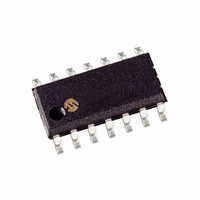PIC16F688-I/SL Microchip Technology, PIC16F688-I/SL Datasheet - Page 91

PIC16F688-I/SL
Manufacturer Part Number
PIC16F688-I/SL
Description
IC PIC MCU FLASH 4KX14 14SOIC
Manufacturer
Microchip Technology
Series
PIC® 16Fr
Datasheets
1.PIC16F616T-ISL.pdf
(8 pages)
2.PIC16F688T-ISL.pdf
(204 pages)
3.PIC16F688T-ISL.pdf
(6 pages)
4.PIC16F688T-ISL.pdf
(4 pages)
5.PIC16F688T-ISL.pdf
(688 pages)
6.PIC16F688-EP.pdf
(174 pages)
Specifications of PIC16F688-I/SL
Program Memory Type
FLASH
Program Memory Size
7KB (4K x 14)
Package / Case
14-SOIC (3.9mm Width), 14-SOL
Core Processor
PIC
Core Size
8-Bit
Speed
20MHz
Connectivity
UART/USART
Peripherals
Brown-out Detect/Reset, POR, WDT
Number Of I /o
12
Eeprom Size
256 x 8
Ram Size
256 x 8
Voltage - Supply (vcc/vdd)
2 V ~ 5.5 V
Data Converters
A/D 8x10b
Oscillator Type
Internal
Operating Temperature
-40°C ~ 85°C
Processor Series
PIC16F
Core
PIC
Data Bus Width
8 bit
Data Ram Size
256 B
Interface Type
SCI, USART
Maximum Clock Frequency
20 MHz
Number Of Programmable I/os
12
Number Of Timers
1
Operating Supply Voltage
2 V to 5.5 V
Maximum Operating Temperature
+ 85 C
Mounting Style
SMD/SMT
3rd Party Development Tools
52715-96, 52716-328, 52717-734
Development Tools By Supplier
PG164130, DV164035, DV244005, DV164005, PG164120, ICE2000, DM163014, DM164120-4
Minimum Operating Temperature
- 40 C
On-chip Adc
8 bit
Lead Free Status / RoHS Status
Lead free / RoHS Compliant
For Use With
XLT14SO-1 - SOCKET TRANSITION 14SOIC 150/208AC162061 - HEADER INTRFC MPLAB ICD2 20PINAC162056 - HEADER INTERFACE ICD2 16F688
Lead Free Status / Rohs Status
Lead free / RoHS Compliant
Available stocks
Company
Part Number
Manufacturer
Quantity
Price
Company:
Part Number:
PIC16F688-I/SL
Manufacturer:
MICROCHIP
Quantity:
4 952
Company:
Part Number:
PIC16F688-I/SL
Manufacturer:
Microchip Technology
Quantity:
27 564
Part Number:
PIC16F688-I/SL
Manufacturer:
MICROCHIP/微芯
Quantity:
20 000
10.3.2
The receiver block diagram is shown in Figure 10-5.
The data is received on the RC5/RX/DT pin and drives
the data recovery block. The data recovery block is
actually a high-speed shifter operating at 16 times the
baud rate, whereas the main receive serial shifter oper-
ates at the bit rate or at F
cally be used in RS-232 systems.
To set up an Asynchronous Reception:
1.
2.
3.
4.
5.
6.
7.
8.
9.
10. If using interrupts, ensure that the GIE and PEIE
FIGURE 10-5:
2004 Microchip Technology Inc.
Initialize the SPBRGH:SPBRG registers for the
appropriate baud rate. Set or clear the BRGH
and BRG16 bits, as required, to achieve the
desired baud rate.
Enable the asynchronous serial port by clearing
bit SYNC and setting bit SPEN.
If interrupts are desired, set enable bit RCIE.
If 9-bit reception is desired, set bit RX9.
Enable the reception by setting bit CREN.
Flag bit RCIF will be set when reception is
complete and an interrupt will be generated if
enable bit RCIE was set.
Read the RCSTA register to get the 9th bit (if
enabled) and determine if any error occurred
during reception.
Read the 8-bit received data by reading the
RCREG register.
If any error occurred, clear the error by clearing
enable bit CREN.
bits in the INTCON register (INTCON<7:6>) are
set.
RC5/RX/DT pin
USART ASYNCHRONOUS
RECEIVER
BRG16
USART RECEIVE BLOCK DIAGRAM
SPBRGH
Baud Rate Generator
OSC
x64 Baud Rate CLK
. This mode would typi-
Pin Buffer
and Control
SPEN
SPBRG
Preliminary
Data
Recovery
Interrupt
or
or
64
16
4
CREN
10.3.3
This mode would typically be used in RS-485 systems.
To set up an Asynchronous Reception with Address
Detect Enable:
1.
2.
3.
4.
5.
6.
7.
8.
9.
10. If any error occurred, clear the CREN bit.
11. If the device has been addressed, clear the
Initialize the SPBRGH:SPBRG registers for the
appropriate baud rate. Set or clear the BRGH
and BRG16 bits, as required, to achieve the
desired baud rate.
Enable the asynchronous serial port by clearing
the SYNC bit and setting the SPEN bit.
If interrupts are required, set the RCEN bit and
select the desired priority level with the RCIP bit.
Set the RX9 bit to enable 9-bit reception.
Set the ADDEN bit to enable address detect.
Enable reception by setting the CREN bit.
The RCIF bit will be set when reception is
complete. The interrupt will be acknowledged if
the RCIE and GIE bits are set.
Read the RCSTA register to determine if any
error occurred during reception, as well as read
bit 9 of data (if applicable).
Read RCREG to determine if the device is being
addressed.
ADDEN bit to allow all received data into the
receive buffer and interrupt the CPU.
RX9
Stop
MSb
RCIF
RCIE
SETTING UP 9-BIT MODE WITH
ADDRESS DETECT
RX9D
(8)
OERR
7
RSR Register
RCREG Register
8
PIC16F688
Data Bus
FERR
1
0
DS41203B-page 89
START
LSb
RCIDL
FIFO




















